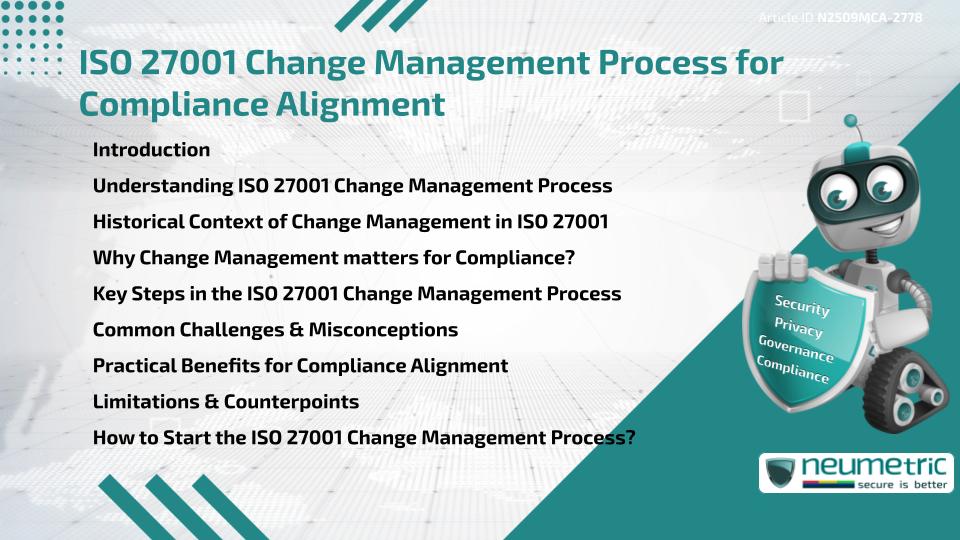Table of Contents
ToggleIntroduction
The ISO 27001 Change Management Process is a critical component of maintaining Compliance & strengthening Information Security practices. This process ensures that changes to Systems, Policies & Procedures do not introduce new Risks or compromise Compliance with Regulatory Standards. For business leaders, adopting a structured approach to Change Management under ISO 27001 is essential for protecting Sensitive Data, avoiding Disruptions & aligning with Compliance goals. This article explores its background, importance, steps, challenges & benefits for Organisations.
Understanding ISO 27001 Change Management Process
ISO 27001 requires Organisations to implement a systematic Change Management Process as part of the Information Security Management System [ISMS]. The process involves identifying, assessing, approving & monitoring changes. It ensures that every modification-whether technological, procedural or organisational-is carefully evaluated for potential security impacts.
Historical Context of Change Management in ISO 27001
Change management has long been a cornerstone of quality & security frameworks. From its early use in IT Service Management standards to its integration into ISO 27001, the concept has evolved to address Risks associated with digital transformation. This historical progression highlights why a formalised Change Management Process is necessary for protecting information assets in today’s interconnected world.
Why Change Management matters for Compliance?
Uncontrolled changes can lead to Security Breaches, Compliance failures & Operational inefficiencies. The ISO 27001 Change Management Process provides a safeguard by ensuring every change is properly documented, reviewed & approved. For Compliance alignment, it demonstrates to Regulators & Auditors that the organisation maintains Oversight & Control over its Information Security environment.
Key Steps in the ISO 27001 Change Management Process
- Initiation: Proposing the change with clear objectives.
- Impact Assessment: Evaluating potential Risks & Compliance implications.
- Approval: Formal authorisation from management or designated authorities.
- Implementation: Executing the change in a controlled manner.
- Testing & validation: Ensuring the change does not introduce new Risks.
- Review & closure: Documenting results & updating Policies if required.
These steps provide a structured pathway to align change with Compliance & Risk Management goals.
Common Challenges & Misconceptions
A common misconception is that Change Management slows down innovation. In reality, the ISO 27001 Change Management Process enables safe innovation by ensuring that changes are Secure & Compliant. Another challenge is resistance from Employees who see the process as bureaucratic. Effective Communication & Leadership involvement can address these concerns.
Practical Benefits for Compliance Alignment
The ISO 27001 Change Management Process offers several practical advantages:
- Reduced Risk of non-compliance penalties.
- Stronger alignment between Business Operations & Regulatory requirements.
- Improved Transparency & Accountability for changes.
- Greater organisational resilience through controlled Risk Management.
- Enhanced Trust from Customers, Partners & Regulators.
Limitations & Counterpoints
While valuable, the process requires resources, documentation & training. Smaller Organisations may find it difficult to allocate time & staff. Additionally, overemphasis on process can sometimes create unnecessary delays. The key is balance: ensuring Compliance while maintaining Operational Efficiency.
How to Start the ISO 27001 Change Management Process?
Business leaders should begin by defining a clear policy for managing changes & training staff to follow it consistently. Using templates & digital tools can streamline documentation & approvals. Leadership commitment is critical, as it sets the tone for company-wide adoption. By approaching the ISO 27001 Change Management Process as a strategic initiative, Organisations can strengthen both Compliance & Business Resilience.
Takeaways
- The ISO 27001 Change Management Process aligns changes with Compliance & Security.
- It reduces Risks from Uncontrolled Modifications.
- Strong documentation & approval are central to its success.
- Employee engagement & Leadership support are crucial.
- The process enables Innovation while maintaining Compliance.
FAQ
What is the ISO 27001 Change Management Process?
It is a structured method for managing organisational changes to ensure Compliance & reduce Security Risks.
Why is the ISO 27001 Change Management Process important?
It prevents uncontrolled changes from creating Security Vulnerabilities or Compliance failures.
Who is responsible for the ISO 27001 Change Management Process?
Leadership, Compliance teams & Employees all play roles, but management oversight is essential.
Does the ISO 27001 Change Management Process slow down innovation?
No, it supports safe Innovation by controlling Risks associated with changes.
How can Small Businesses implement the ISO 27001 Change Management Process?
They can scale the process by using simple templates & prioritising high-Risk changes.
What happens if a change bypasses the process?
It can lead to Compliance Breaches, Security Incidents or Audit failures.
Need help for Security, Privacy, Governance & VAPT?
Neumetric provides organisations the necessary help to achieve their Cybersecurity, Compliance, Governance, Privacy, Certifications & Pentesting needs.
Organisations & Businesses, specifically those which provide SaaS & AI Solutions in the Fintech, BFSI & other regulated sectors, usually need a Cybersecurity Partner for meeting & maintaining the ongoing Security & Privacy needs & requirements of their Enterprise Clients & Privacy conscious Customers.
SOC 2, ISO 27001, ISO 42001, NIST, HIPAA, HECVAT, EU GDPR are some of the Frameworks that are served by Fusion – a SaaS, multimodular, multitenant, centralised, automated, Cybersecurity & Compliance Management system.
Neumetric also provides Expert Services for technical security which covers VAPT for Web Applications, APIs, iOS & Android Mobile Apps, Security Testing for AWS & other Cloud Environments & Cloud Infrastructure & other similar scopes.
Reach out to us by Email or filling out the Contact Form…


